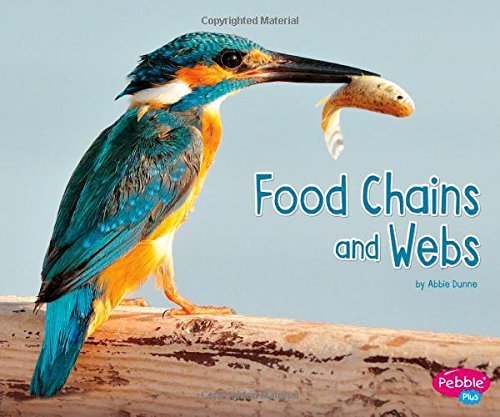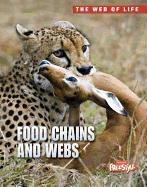-
Who Eats What?: Food Chains and Food Webs
Patricia Lauber, Holly Keller
Paperback (HarperCollins, Feb. 2, 2016)What do you and a tuna have in common? You are both part of a food chain that begins with green things and ends with you! Can you get energy from sunlight? Why is every link in a food chain important? Read and find out more about food chains! This nonfiction picture book is an excellent choice to share during homeschooling, in particular for children ages 4 to 6. It’s a fun way to learn to read and as a supplement for activity books for children.Now rebranded with a new cover look, this book features content-rich vocabulary in simple, engaging text by Patricia Lauber, fascinating diagrams, and beautifully detailed illustrations by Holly Keller. Both text and artwork were vetted for accuracy.This is a Level 2 Let's-Read-and-Find-Out Science title, which means the book explores more challenging concepts for children in the primary grades and supports the Common Core Learning Standards, Next Generation Science Standards, and the Science, Technology, Engineering, and Math (STEM) standards. Let's-Read-and-Find-Out Science is the winner of the American Association for the Advancement of Science/Subaru Science Books & Films Prize for Outstanding Science Series. M
M
-
Who Eats What? Food Chains and Food Webs
Patricia Lauber, Holly Keller
Paperback (HarperCollins, Dec. 14, 1994)Informative and intriguing, this science book teaches children to think about the complex and interdependent web of life on Earth. Every link in a food chain is important because each living thing depends on others for survival, no matter how big or how small. Lively drawings from Holly Keller illustrate the clear, simple text by Patricia Lauber. This is a Stage 2 Let's-Read-and-Find-Out, which means the book explores more challenging concepts for children in the primary grades. Let's-Read-And-Find-Out is the winner of the American Association for the Advancement of Science/Subaru Science Books & Films Prize for Outstanding Science Series. Supports the Common Core Learning Standards and Next Generation Science Standards M
M
-
What Are Food Chains and Webs?
Bobbie Kalman
Paperback (Crabtree Pub Co, March 15, 1998)A simple introduction to food chains and webs, featuring both herbivores and carnivores and discussing energy, food production, and decomposition in various ecosystems Q
Q
-
Who Eats What?: Food Chains and Food Webs
Patricia Lauber, Holly Keller
Hardcover (Harpercollins Childrens Books, Jan. 1, 1995)Explains the concept of a food chain and how plants, animals, and humans are ecologically linked M
M
-
Who Eats What?: Food Chains and Food Webs
Patricia Lauber, Holly Keller
Library Binding (Paw Prints 2009-07-10, April 9, 2009)An award-winning author and artist explain how every link in a food chain is important because each living thing depends on others for survival. "Clear, simple drawings illustrate the clear, simple text. Informative and intriguing, this basic science book leads children to think about the complex and interdependent web of life on Earth."'BL. Outstanding Science Trade Books for Children 1996 (NSTA/CBC) M
M
-
Who Eats What?: Food Chains and Food Webs
Patricia Lauber, Holly Keller
Library Binding (Perfection Learning, Jan. 1, 1995)An award-winning author and artist explain how every link in a food chain is important because each living thing depends on others for survival. "Clear, simple drawings illustrate the clear, simple text. Informative and intriguing, this basic science book leads children to think about the complex and interdependent web of life on Earth."'BL. Outstanding Science Trade Books for Children 1996 (NSTA/CBC) M
M
-
Food Chains and Webs
Abbie Dunne
Paperback (Capstone Press, Aug. 1, 2016)Simple text and bright photographs explain the concept of food chains and webs for beginning readers. The book concludes with a simple, kid-friendly activity. M
M
-
Food Chains and Webs
Andrew Solway
Paperback (Raintree, Jan. 1, 2012)Food Chains and Webs explains that feeding relationships are at the heart of life on Earth. It looks at the different types of living things in a food web - from producer to top consumer - as well as food pyramids and topics like bioaccumulation. It tackles common confusions about the science and shows how topics are relevant to the reader.
-
Who Eats What? Food Chains and Food Webs
Patricia Lauber, Holly Keller
Library Binding (HarperCollins, Feb. 23, 1995)An award-winning author and artist explain how every link in a food chain is important because each living thing depends on others for survival. "Clear, simple drawings illustrate the clear, simple text. Informative and intriguing, this basic science book leads children to think about the complex and interdependent web of life on Earth."'BL. Outstanding Science Trade Books for Children 1996 (NSTA/CBC) M
M
-
Food Chains and Webs
Andrew Solway
Paperback (Raintree, Jan. 1, 2012)Food Chains and Webs explains that feeding relationships are at the heart of life on Earth. It looks at the different types of living things in a food web - from producer to top consumer - as well as food pyramids and topics like bioaccumulation. It tackles common confusions about the science and shows how topics are relevant to the reader.
-
Who eats what?: Food chains and food webs
Patricia Lauber
Paperback (Scholastic, Aug. 16, 2002)An award-winning author and artist explain how every link in a food chain is important because each living thing depends on others for survival. "Clear, simple drawings illustrate the clear, simple text. Informative and intriguing, this basic science book leads children to think about the complex and interdependent web of life on Earth."'BL. Outstanding Science Trade Books for Children 1996 (NSTA/CBC) M
M
-
Food Webs: Who Eats What?
Claire Llewellyn
Paperback (Raintree, Jan. 1, 2014)This exciting book about the predator/prey relationship teaches readers about food webs. N
N